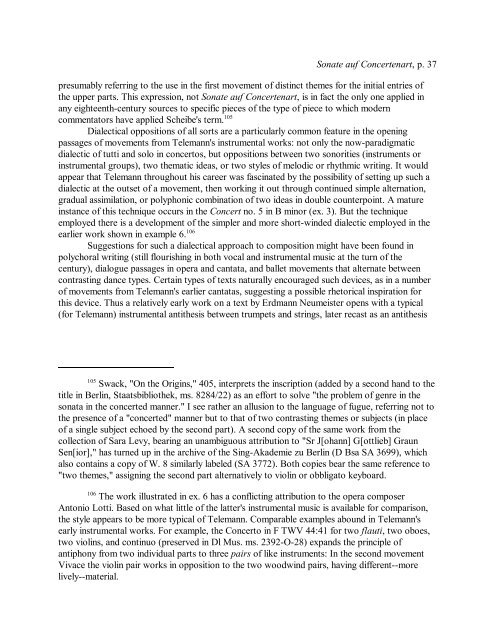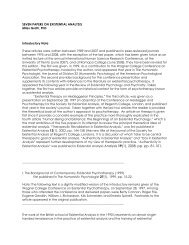The Sonate auf Concertenart: A Postmodern Invention? David ...
The Sonate auf Concertenart: A Postmodern Invention? David ...
The Sonate auf Concertenart: A Postmodern Invention? David ...
Create successful ePaper yourself
Turn your PDF publications into a flip-book with our unique Google optimized e-Paper software.
<strong>Sonate</strong> <strong>auf</strong> <strong>Concertenart</strong>, p. 37<br />
presumably referring to the use in the first movement of distinct themes for the initial entries of<br />
the upper parts. This expression, not <strong>Sonate</strong> <strong>auf</strong> <strong>Concertenart</strong>, is in fact the only one applied in<br />
any eighteenth-century sources to specific pieces of the type of piece to which modern<br />
commentators have applied Scheibe's term. 105<br />
Dialectical oppositions of all sorts are a particularly common feature in the opening<br />
passages of movements from Telemann's instrumental works: not only the now-paradigmatic<br />
dialectic of tutti and solo in concertos, but oppositions between two sonorities (instruments or<br />
instrumental groups), two thematic ideas, or two styles of melodic or rhythmic writing. It would<br />
appear that Telemann throughout his career was fascinated by the possibility of setting up such a<br />
dialectic at the outset of a movement, then working it out through continued simple alternation,<br />
gradual assimilation, or polyphonic combination of two ideas in double counterpoint. A mature<br />
instance of this technique occurs in the Concert no. 5 in B minor (ex. 3). But the technique<br />
employed there is a development of the simpler and more short-winded dialectic employed in the<br />
earlier work shown in example 6. 106<br />
Suggestions for such a dialectical approach to composition might have been found in<br />
polychoral writing (still flourishing in both vocal and instrumental music at the turn of the<br />
century), dialogue passages in opera and cantata, and ballet movements that alternate between<br />
contrasting dance types. Certain types of texts naturally encouraged such devices, as in a number<br />
of movements from Telemann's earlier cantatas, suggesting a possible rhetorical inspiration for<br />
this device. Thus a relatively early work on a text by Erdmann Neumeister opens with a typical<br />
(for Telemann) instrumental antithesis between trumpets and strings, later recast as an antithesis<br />
105<br />
Swack, "On the Origins," 405, interprets the inscription (added by a second hand to the<br />
title in Berlin, Staatsbibliothek, ms. 8284/22) as an effort to solve "the problem of genre in the<br />
sonata in the concerted manner." I see rather an allusion to the language of fugue, referring not to<br />
the presence of a "concerted" manner but to that of two contrasting themes or subjects (in place<br />
of a single subject echoed by the second part). A second copy of the same work from the<br />
collection of Sara Levy, bearing an unambiguous attribution to "Sr J[ohann] G[ottlieb] Graun<br />
Sen[ior]," has turned up in the archive of the Sing-Akademie zu Berlin (D Bsa SA 3699), which<br />
also contains a copy of W. 8 similarly labeled (SA 3772). Both copies bear the same reference to<br />
"two themes," assigning the second part alternatively to violin or obbligato keyboard.<br />
106<br />
<strong>The</strong> work illustrated in ex. 6 has a conflicting attribution to the opera composer<br />
Antonio Lotti. Based on what little of the latter's instrumental music is available for comparison,<br />
the style appears to be more typical of Telemann. Comparable examples abound in Telemann's<br />
early instrumental works. For example, the Concerto in F TWV 44:41 for two flauti, two oboes,<br />
two violins, and continuo (preserved in Dl Mus. ms. 2392-O-28) expands the principle of<br />
antiphony from two individual parts to three pairs of like instruments: In the second movement<br />
Vivace the violin pair works in opposition to the two woodwind pairs, having different--more<br />
lively--material.















